Environmental Impact of Fast Fashion Statistics (2025)

People worldwide are buying more clothes than they did a decade ago, and fast fashion has taken the center stage to meet the ever rising demand. Fast fashion has taken a toll on the environment and the people who work in the industry. Longer working hours with lesser pay is causing another pandemic behind the curtains.
The environmental impact of fast fashion is undeniable, with the industry now responsible for 10% of the global annual carbon footprint, which is more than the emissions from all international flights and maritime shipping combined. Beyond carbon emissions, fast fashion consumes vast amounts of natural resources, using 141 billion cubic meters of water annually and contributing to 35% of microplastics polluting our oceans.
To understand the full scope of this issue, let’s take a look at the environmental impact of fast fashion through statistics in this post. We will also dive into the demographics and workforce insights of the fast fashion industry.
Global fast fashion market size
Fast fashion is now a $150.82 billion industry, it has grown by 10.74% from 2024 and is further estimated to reach $291.1 billion by 2032.
This shows that although more people are advocating for sustainable fashion, the majority don’t want to give up fast fashion. This is the reason the industry will keep growing at a 10.7% CAGR from 2024 to 2032.
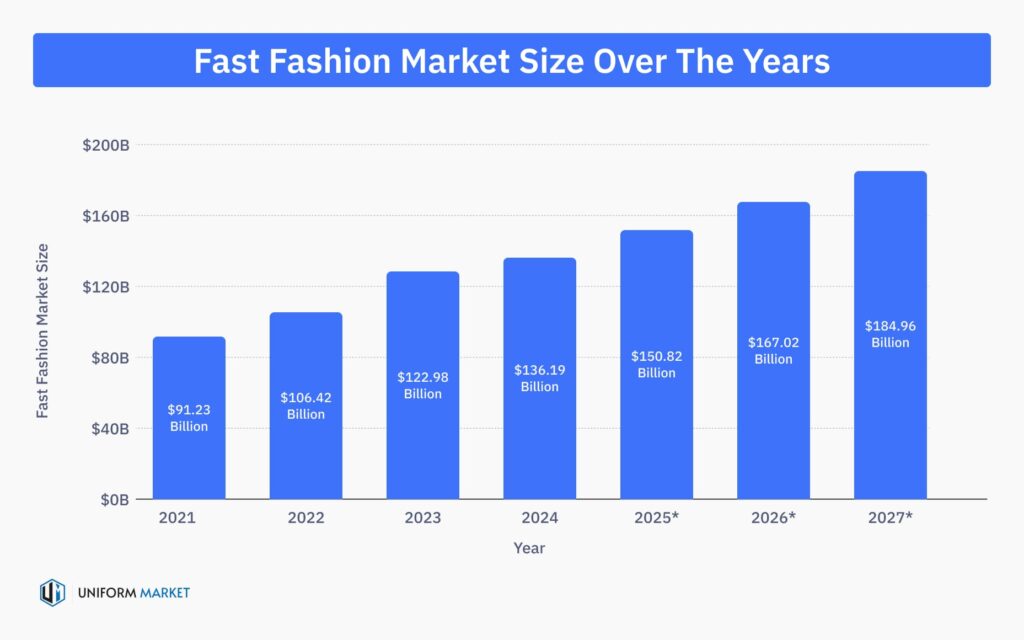
| Year | Fast Fashion Market Size |
|---|---|
| 2021 | $91.23 billion |
| 2022 | $106.42 billion |
| 2023 | $122.98 billion |
| 2024 | $136.19 billion |
| 2025 | $150.82 billion |
| 2026* | $167.02 billion |
| 2027* | $184.96 billion |
The biggest players in fast fashion
Shein is the biggest fast fashion brand in the US with a 50% market share, its market share has doubled since March 2020. Zara is the second biggest fast fashion brand in the country with a 13% market share.
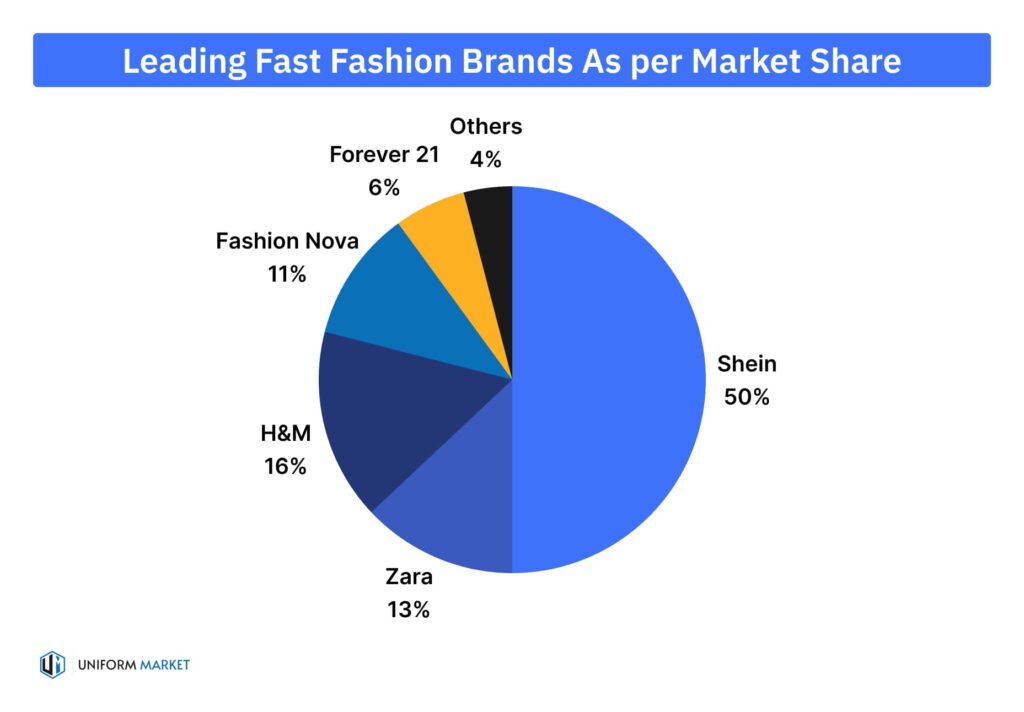
Here is a table showing the United States’ biggest fast fashion brands.
| Fast Fashion Brand | Market Share in US |
|---|---|
| Shein | 50% |
| Zara | 13% |
| H&M | 16% |
| Fashion Nova | 11% |
| Forever 21 | 6% |
People wear fast fashion less often than 15 years ago
Nowadays, clothing is worn only 7 to 10 times before being thrown away — a decline of more than 35% in just 15 years. This highlights the rise of fast fashion, and underscores the importance of adopting more sustainable shopping habits to lessen our environmental footprint.
Workers in the fast fashion industry are paid as little as $1.58 per hour
The U.S. Department of Labor found that 80% of contractors were breaking laws on minimum wage and overtime pay. They recovered over $892,000 in unpaid wages and damages. They caught one contractor paying garment workers only $1.58 per hour in a state where the minimum wage was $15 per hour.
Did you know? 430 million people work in the fashion and textile market?
Gen Z wants sustainable fashion but won't give up on fast fashion
It’s safe to say that Gen Z is a hypocrite in the fast fashion case, a SHU study uncovered a paradox among Gen Z fashion consumers, 94% of respondents said they support sustainable clothing but surprisingly 17% of them shopped at a fast fashion retailer every week, and 62% did so monthly. Only 10% claimed to have never purchased from fast fashion outlets.
The age group spends $767 on average every year buying fast fashion.
Women are the largest consumers of fast fashion
Women tend to shop for clothes more often than men, buying nearly twice as many expensive jeans and keeping up with seasonal trends. Many women see shopping as a fun activity to do with friends and family. About 41% of young women feel pressured not to wear the same outfit twice when they go out. Meanwhile, men generally shop less frequently and are slower to change their fashion habits.
A woman aged 18 to 24 is the most frequent consumer of fast fashion!
People with higher incomes generate more textile waste
People with higher incomes generate, on average, 76% more clothing waste than people with lower incomes. Richer countries produce 95.7 pounds of textile waste per person each year, while poorer countries produce 54.7 pounds per person annually.
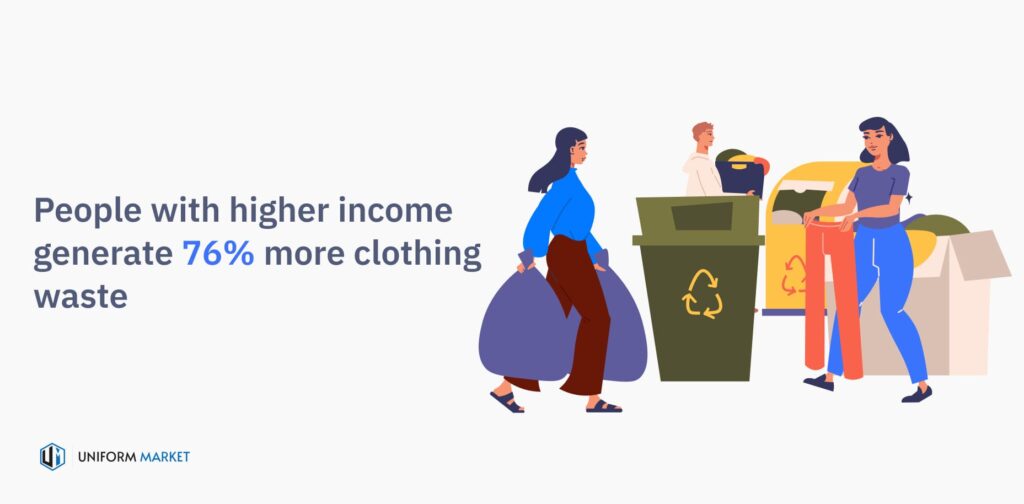
Fast Fashion is the third biggest polluter in the world
The fashion industry is responsible for 10% of the total annual carbon footprint, surpassing the emissions from all international flights and maritime shipping combined. The sector also consumes enough water annually to meet the needs of 5 million people, and generates millions of tons of plastic and other waste, polluting both our air and oceans.
24% of the world’s biggest fashion brands disclose nothing on decarbonisation
Just 4 (ASICS, H&M, Marks & Spencer, and Patagonia) out of the 250 largest fashion brands disclose emission reduction targets that meet the level of ambition called for by the UN, which is a 55% absolute emissions reduction by 2030 from 2018 levels.
57% of the brands show no clear progress on their climate targets.
Source: Fashion Revolution.
Use of natural resources in 2025
If 80% of people in emerging economies reach Western clothing consumption levels by 2025, and the apparel industry doesn’t improve its environmental efficiency, its environmental footprint will significantly increase.
| Natural resource | Usage in 2015 | Usage in 2025 |
|---|---|---|
| Water | 141 billion cubic meters | 170 billion cubic meters |
| Land | 38 million hectares | 41 million hectares |
Currently, clothing companies have not matched their sales growth with gains in environmental and social performance. Cotton, which makes up about 30% of textile fibers, is often produced with high water, pesticide, and fertilizer use. Additionally, producing 1 kilogram of fabric generates around 23 kilograms of greenhouse gases due to reliance on fossil fuels.
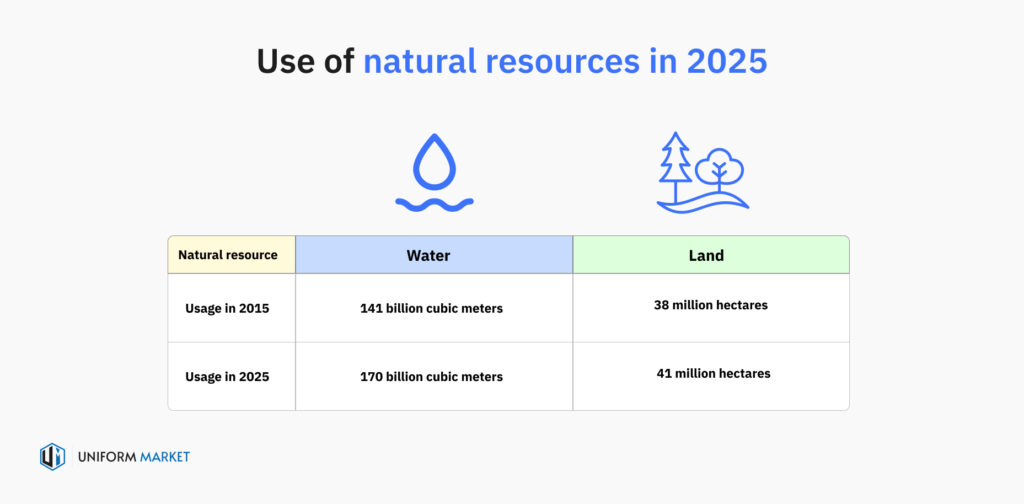
The United States manage to recycle over 2.5 megaton of textile waste each year
The United States generates 15.8 megaton of textile waste every year on average and has managed to recycle over 2.5 megatons of it every year since 2017. That is 15.8% of the total waste.
The recycling rate has seen a decline, back in the 1960s to 1990s, the USA recycled 30% of their total textile waste.
Less than 1% of clothes are recycled to make new clothes
Right now, less than 1% of old clothes are turned into new ones, and the amount of recycled polyester used in clothing is shrinking. In 2019, recycled polyester made up 14% of all polyester used, but by 2030, it’s expected to drop to just 7.9%. Moreover, most recycled polyester in clothes actually comes from recycled plastic bottles, not from old clothes.
70% of clothes are made using synthetic fiber
About 70% of all clothing materials are synthetic fibers, which include materials like elastane, nylon, and acrylic. Polyester alone makes up 52% of all the fibers used to make clothes, making it the most common type.
Laundering a washing load of 13 lbs could release an estimated 496,030 fibers from polyester and 728,789 from acrylic.
35% of microplastics in the ocean are from the materials used to produce fast fashion
An IUCN report estimates that 35% of all microplastics in the ocean come from the laundering of synthetic textiles. Polyester is the main culprit in this case, it accounts for 73% of all microplastics. A typical polyester can keep on shedding microplastics for over 100 years before it degrades.

Fast fashion consumes 1.35% of the world’s oil
The widespread use of inexpensive synthetic fibers have increased the fashion industry’s reliance on fossil fuel. Currently, textile synthetic fiber production consumes 1.35% of the world’s oil supply, which is more than Spain’s annual oil consumption!
It’s projected that synthetic fibers, which currently make up 69% of all fibers used, will increase to 73% by 2030. Polyester alone will make up 85% of these synthetic fibers. Essentially, if the fashion industry keeps going as it is, in less than 10 years, almost three-quarters of our clothes will be made from materials derived from fossil fuels.
Over 11.3 megatons of textile waste ends up in US landfills every year
11.3 megatons of textile waste ends up in the landfills every year since 2017, that is 80% more waste than the year 2000. This can be attributed to the rapidly increasing population, especially of Gen Z.
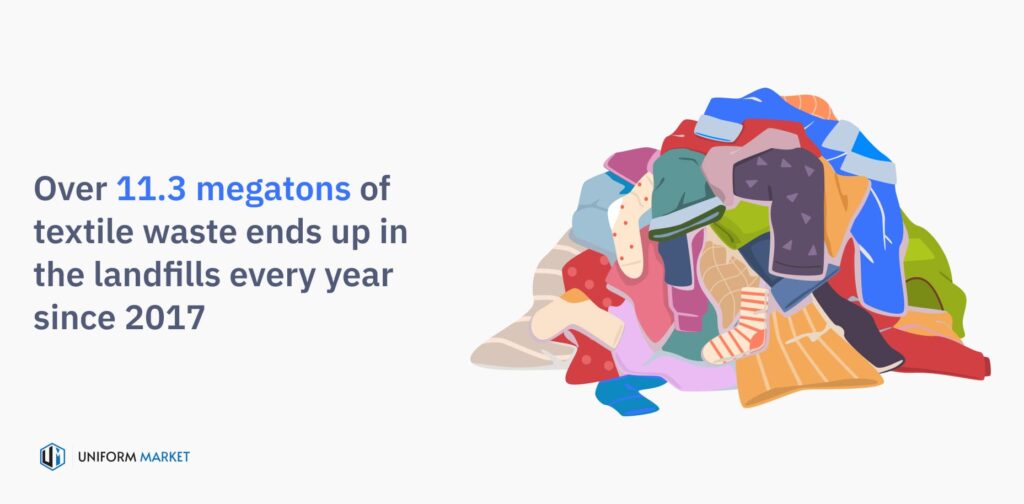
Most Landfills are located in areas where BIPOC residents live
Landfills are nearly 3 times more likely to be found in neighborhoods where a larger percentage of BIPOC (Black, Indigenous, and People of Color) residents live, compared to other areas.
Ultimately, up to half of textile waste is just sent overseas to countries in the Global South, where it often ends up in landfills.
Ready to launch your next
Employee Program?
Uniform Programs?
Company Stores?
Group Stores?
Team Stores?
Swag Stores?
Brand Stores?
Event Stores?
Distributor Portals?
Enabling uniforms and promotional product suppliers with eCommerce solutions to manage B2B, B2B2C, and Direct selling from one central platform.

